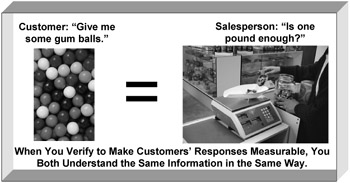The Power of the Four Types of Questions
Your most powerful selling tools involve four types of questions: dialoguing, qualifying, clarifying, and verifying. The last three make customers' responses progress from vague to clearer to measurable. You end up exactly where you and your customers need to be—with measurable goals and filters.
Dialoguing
You use dialoguing to break the ice and make everyone feel comfortable without falling in the water. "How do you like this cold weather?" Dialoguing creates comfort levels or rapport between you and customers. These exchanges do not include discussions about goals, filters, products, and services. Use dialoguing to establish common ground. You also know by now not to be the four thousandth salesperson to ask about the picture of a sailboat hanging on a customer's wall.
The use of open-ended questions encourages unguarded conversation and humor. It also gives a sense of each other's mannerisms and personalities. This verbal insight assists you in determining what sort of formality, pace, and levity to use in the sales calls. If customers only laugh when you say good-bye, you might reconsider how well you read their comments.
Do not merely listen for clues to their styles; look for them, too. Even without a degree in psychology, you might notice certain visual clues. Customers stealing glances at their watches might suggest either impatience or self-importance. Answering telephones as they motion you to stay where you are, and then talking for twenty minutes might suggest two things; okay three if you count rudeness. They either consider themselves very important or you not very important. Your focus on their goals and filters will make them feel important—and let them know you are important to their efforts in achieving them.
Listen for verbal clues, too. "I have a hectic schedule" leaves nothing for the imagination. So does the all-time favorite, "What's on your mind?" These subtle hints also reflect their degree of patience, sense of self-importance, and level of attentiveness. Be ready to shift from dialoguing to qualifying at a moment's notice. Dialoguing consists of open-ended questions. These, as mentioned before in the How's Zat? section, start with who, what, why, when, where, and how. Avoid seeking yes-or-no answers when trying to drum up conversation. A word of caution: Do not forget how a "no" answer can be a conversation-killer.
Qualifying
Qualifying is the first questioning process you learn how to use. You probably define the word qualifying as what you do on the first call to find out whether you can sell customers something. Qualifying can mean nearly anything. Is it finding out their level of pain? Is it uncovering their sense of urgency? Is it reinforcing how well they like you? Is it discovering they have money? You know better.
You know qualifying means not wasting anyone's time. Therefore, qualifying starts with helping customers to gather information about their goals, filters, measurable benefits, and systems of evaluations. You first qualify customers on their ability to achieve their goals, not buy your products. Qualifying questions are open-ended. As expected, your first line of questioning most often results in vague responses. Qualifying questions, like dialoguing questions, never seek yes or no answers. The reward for saving those yes or no questions until the end is worth it.
Example
-
Customer: We want to improve our productivity.
-
Salesperson: What will that involve? (This qualifying question seeks details on what the goal of improving productivity means.)
Okay, be honest. Were you not tempted to say, "We can help you improve productivity with _______________ (fill in the product or feature)?"
Clarifying
While qualifying points you in the right direction, clarifying helps you make sure you are on the right track. Typically, you use this questioning process on the second in-person sales call when you realize there are still a lot of unknowns left over from the first call. When you follow your qualifying questions with clarifying questions, you save time and reduce wasted efforts. Customers' measurable answers help them and you decide whether it makes sense for a third sales call.
Your clarifying questions turn vague responses into measurable responses. They become more measurable in terms of time or money. Clarified answers define customers' goals and filters and how they measure value. Your clarifying questions also are open-ended and do not seek yes or no answers. Clarifying means never having to say you are sorry for unfulfilled goals, wasted time, or money.
Example
-
Customer: I want to reduce the number of defects to improve productivity.
-
Salesperson: What do defect costs run annually? (Clarifying question to make the costs of defects measurable)
-
Customer: Defects cost us about $250,000 a year.
-
Salesperson: What sort of savings are you looking to achieve? (Second clarifying question to make their savings measurable)
Verifying
Verifying is the questioning process that uses yes-or-no questions. If you qualified and clarified properly, you should end up with yes answers. Chapter 8 explains how to handle "no" answers. Verifying confirms there are full agreements on the specifics of goals and filters. Verifying requires the use of yes-or-no questions that confirm you and the customers both understand their measurable points the same way. (See Exhibit 5-3.)

Exhibit 5-3: Verify customers' responses.
Example
-
Customer: We feel we can reduce $250,000 of defects by 30 percent.
-
Salesperson: So, your goal is to decrease defect costs by $75,000? (Verifies the cost savings target)
-
Customer: That's right.
EAN: 2147483647
Pages: 170